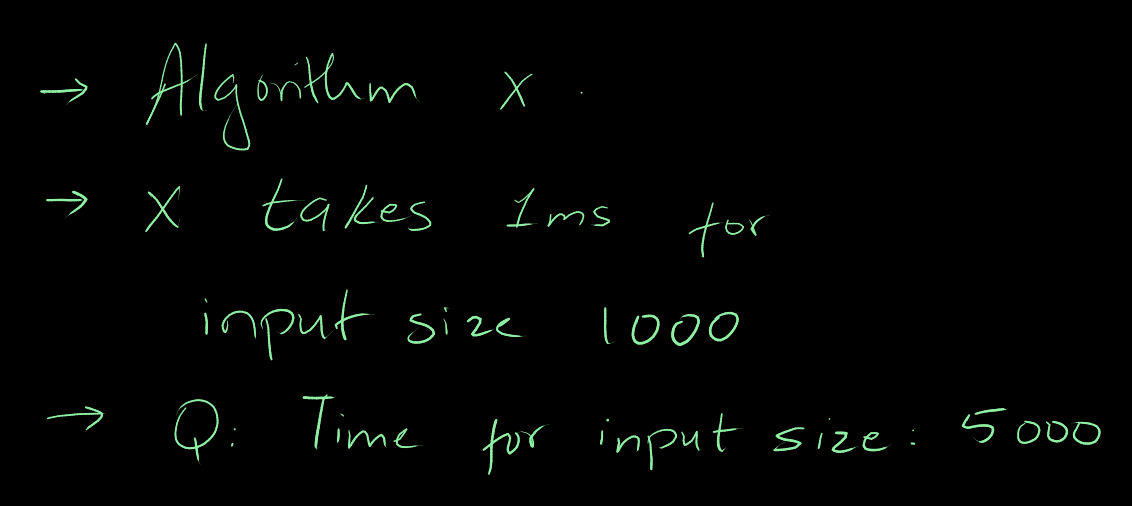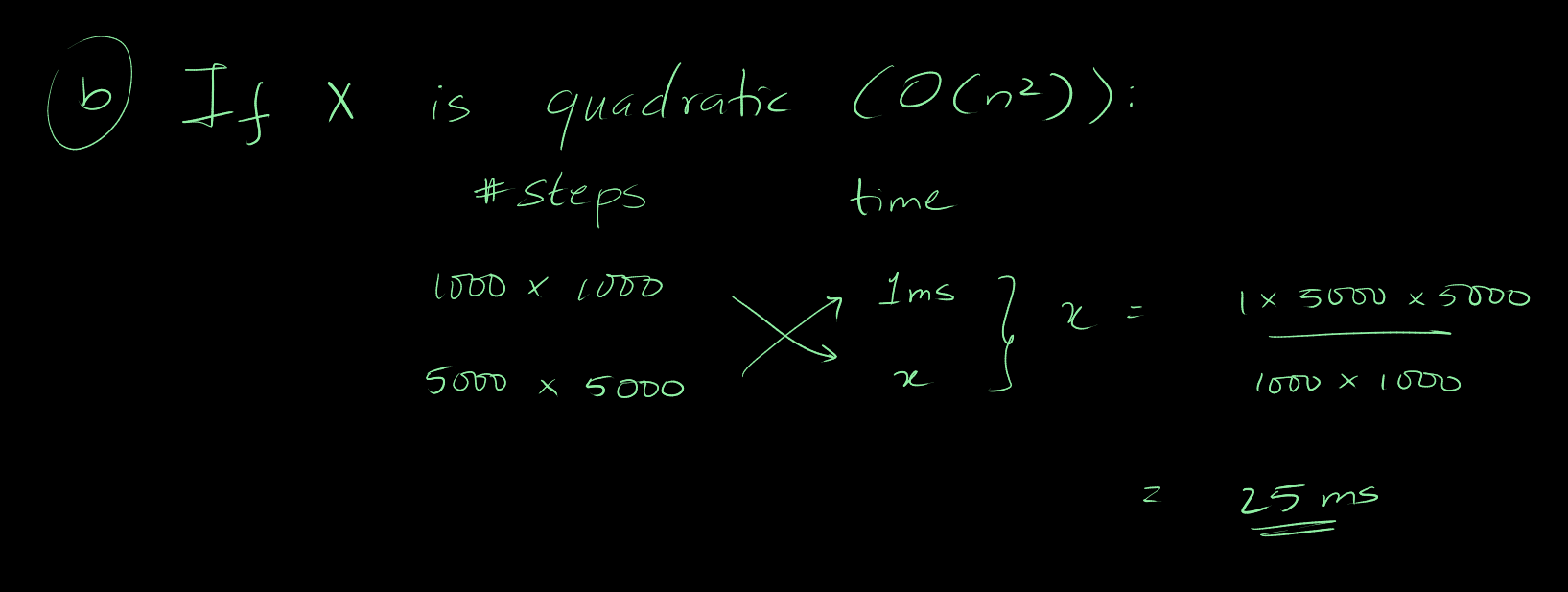Time Complexity
The time complexity of an algorithm is a way of discussing the efficiency of an
algorithm. This helps us talk about the way the algorithm scales and how it
much longer time it would take on having to process larger data.
O notation
Wikipedia Big O Notation
A function f(n) is said to be of the order g(n) written as, O(g(n)), if there
exists positive constants C and n0 such that f(n) <= C g(n) ∀ n >=
n0.
Big O notation is a mathematical notation that describes the limiting behavior
of a function when the argument tends towards a particular value or infinity.
Time Calculations
Calculate the time of a particular algorithm
We can measure the complexity of a particular algorithm by counting the number
of basic operations that are performed.
Example Algorithm to find the largest integer in an array of n integers.
public static int findLargest(int[] arr) {
int largest = arr[0]; int
index = 1;
while (index < arr.length) { // Runs n times
if (arr[index] > largest) // Runs n-1 times
largest = arr[index]; // Runs n-1 times
index++; // Runs n-1 times
}
return largest;
}
The sum of the number of operations performed:
n + (n-1) + (n-1) + (n-1) + (n-1) = 4n - 3
We can assume that the time taken to perform all the basic operations takes the
same time in most cases. For this particular case, let's assume the time taken
for 1 single operation is t.
So, the total time taken by the algorithm would be 4nt - 3t.
When an algorithm performs better for large values of n, it's referred to as
the asymptotic complexity.
This would have a Big-O complexity of O(n) since the fastest scaling factor
in the terms in the equation is n.
Given Data Size, Estimate Time
If we're given an O notation, the time equation of a given algorithm, and the
time for a given input, we can calculate the for a different input size.
Example:
Question: An Algorithm X takes 1 ms for an input size of 1000. Approximate the
time taken for an input size of 5000.

Part 1: If Algorithm X is linear.

Part 2: If Algorithm X is quadratic.

The thing we're doing in the above solution is just finding the time it takes
to perform a single step and then multiplying that by the number of total
steps. We just do all that in the cross-multiplication.
Data Structures
A data structure is a collection of data items that are grouped together with
certain operations defined on them.
Unordered Lists
An unordered list is a simple linear collection of unordered data items.
Operations Defined
- Add an item to the list.
- Remove a specific item from the list.
- Step through all the items.
- Search the list for a specific item.
We can use an Array to represent an unordered list, but since they store
successive items in consecutive memory, the deletion of random items requires
items to be moved. We can use a linked list to solve this problem.
Linked List
A linked list is a linear data structure consisting of nodes. Each node holds a
data item and a link to the next node.

We store a pointer to the start of the linked list, and then each node points
to the next. The last node points to null to represent the end of the list.
Advantages
- Memory is allocated and de-allocated on-demand.
- No memory wasted, thanks to the first advantage.
- Items can be inserted and deleted without affecting other entries.
Disadvantages
- Doesn't allow random access of nodes.
- More memory is required compared to an array since you need to store an extra
pointer to the next node.
Implementation
Here is an implementation in Java: Suchith
Github
There are other languages in which the linked list has been implemented if you
look around the same repository.
Ordered Lists
An ordered list is a linear collection of items in which the items are arranged
in either ascending or descending order of keys. The key is one part of the
item. It servers as the basis of ordering. An ordered list is sorted and
maintained sorted, even when new items are added or existing items are
deleted. Repetition of keys is usually not allowed.
The primary and pretty much only advantage of ordered lists is that it enables
really fast search. This is thanks to an algorithm called "binary search" which
takes only O(log(n)) in the worst case. This advantage comes at a cost of
inserting and deleting items.
One would use an ordered list in those rare cases where the number of searches
are a lot higher than the number of insertions. A great example of this would
be google's search engine! The number of searches for a web page is much higher
than the number of web pages inserted per day.
For ordered lists to be effective, one would need to use binary search! You can
find more information about it here: Binary Search
Advantages
- Fast search for items using binary search.
Disadvantages
- Insertion time is greatly increased.
Implementation
The implementation can be found over here: Suchith Github Ordered
List
That particular implementation (at the time of writing 2023-Jun-14) allows
duplicate values and uses an ArrayList in java to hold the values of the
elements. It uses binary search whenever possible.
Merging Ordered Lists
We can use an algorithm called the "Two-finger-walking algorithm" to merge two
ordered lists. It just keeps comparing the front elements of the lists and
adding it to a new list.
You can find the implementation in the same file as the Ordered list
implementation.
Trees
A tree is a data structure consisting of a set of nodes arranged in a
hierarchy. There is one special node called the root which is the starting
point of the tree and the root is connected to zero or more nodes at the next
level by branches or links. Similarly, each node at Level i is connected to
zero or more nodes at Level i+1.
- A parent node is the node that the current node is connected to at a level
lower to its level.
- A child node is a node that the current node is connected to at a level
higher to its level.
- A leaf node is a node that does not have any children.
- Non-leaf nodes are called internal nodes.

Binary Trees
A binary tree is a tree in which every node has at most two children.
The maximum number of nodes in a binary tree of height h is 2^(h+1) - 1
Special Types of Binary Trees
-
Strictly Binary Tree: A tree in which every node has either no children
or exactly two children.
-
Complete Binary Tree: In a complete binary tree, every level but the last
must have the maximum number of nodes possible at that level. The last level
may have fewer than maximum possible, but they should be arranged from left
to right without any empty spots.
Binary Search Tree
A binary search tree (BST) is a binary tree that is sorted or ordered according
to a rule. In general, the information contained in each node is a record - one
part is called the key.
A BST is a binary tree in which, for every node x:
- The keys in all the nodes in the left subtree of x are smaller than the key
in x.
- The keys in all the nodes in the right subtree of x are larger than the key
in x.
Example of a binary search tree:
Binary Search Tree
Source: Wikipedia
The binary search tree basically facilitates easier searching of elements,
similar to the binary search algorithm.
Search
- Compare the target key with the value in the root.
- If it is equal, target found.
- If an empty subtree is reached, target not found.
- Otherwise,
- if target is lesser than value, search left subtree.
- if target is greater than value, search right subtree.
Insertion
We just perform the search algorithm as metioned above and then insert it at
the location where the search "ends" (fails).
Note that a new node always becomes a lead node in the BST.
Deletion
Case 1: X is a leaf node
Simply delete X, that is, detach X from its parent.
Algorithms
A binary tree traversal is a systematic method of visiting and processing each
node in the tree.
Order: Root-Left-Right.
Visit the root, traverse the left subtree, traverse the right subtree.
Order: Left-Root-Right.
Traverse the left subtree, Visit the root, traverse the right subtree.
Order: Left-Right-Root.
Traverse the left subtree, traverse the right subtree, Visit the root.
Implementation
Github Suchith Binary
Tree
This implementation uses a recursively defined class BinaryTree.
Huffman Encoding
This is a method of encoding/compressing ASCII data using binary trees. Here's
the article on it: Huffman Encoding
Suchicodes
Algorithms
Searching Algorithms
Binary Search
Binary Search is an algorithm that requires an ordered list of elements. This
algorithm takes advantage of the fact that in an ordered list all elements
before any elements x are smaller than x and any elements after x are greater
than x.
In each iteration, we look at the middle element and decided whether to discard
the top half since the element we're looking for is smaller or discard the
bottom half since the element is larger.
Binary search as a big O complexity of O(log n)!
Idea
Problem: We're trying for find an element x in a sorted list.
- Look at the middle of the list.
- If
x is the element in the middle then found.
- If
x is lower/less than the middle element, discard everything after the middle element.
- If
x is higher/greater than the middle element, discard everything before the middle element.
- Go to step one if more elements present. If not, element not found.
Implementation
The implementation can be found over here: Suchith Github Binary
Search
This particular implementation assumes that the list provided is sorted.